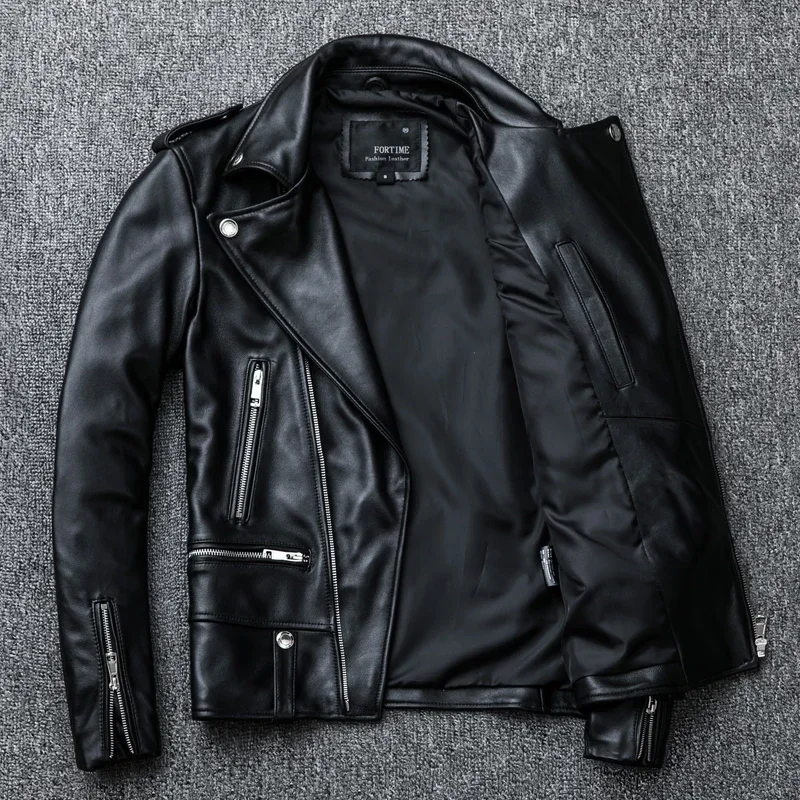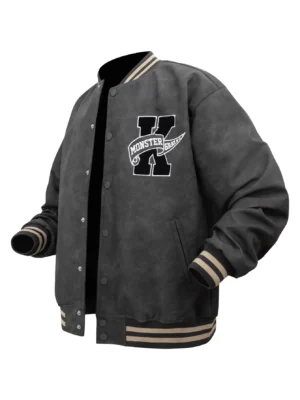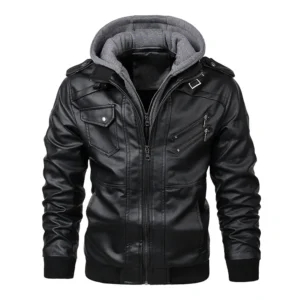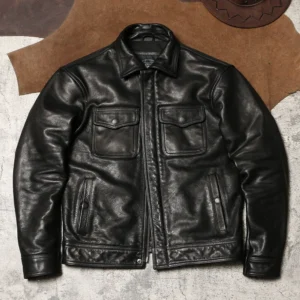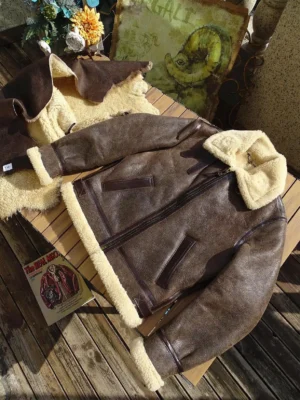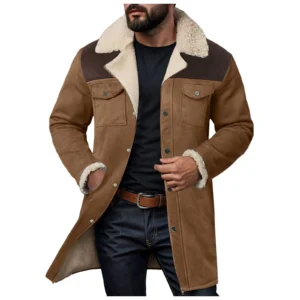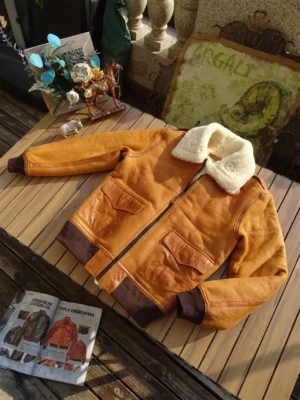Understanding the Timeless Appeal of Black Leather Jackets
The black leather jacket stands as one of the most enduring and versatile pieces in men’s fashion. More than just outerwear, it represents an attitude, a statement of confidence that has remained relevant across generations. What makes these jackets such a coveted wardrobe essential? Their remarkable versatility allows them to transition seamlessly between casual weekend outfits and more polished evening looks.
A quality leather jacket offers exceptional value through its durability. Unlike fast fashion items that deteriorate after a season or two, a well-crafted leather jacket develops character over time, with each scuff and crease telling a story. This natural aging process, known as patina development, actually enhances the jacket’s appearance rather than diminishing it.
The benefits of investing in a quality black leather jacket include:
- Exceptional versatility across seasons and occasions
- Remarkable durability that can span decades with proper care
- Immediate style enhancement for almost any outfit
- Ability to be dressed up or down depending on the situation
- Weather resistance that improves with proper treatment
The cultural significance of leather jackets runs deep, with their image forever intertwined with icons of rebellion, adventure, and timeless cool. From motorcycle culture to Hollywood’s greatest stars, comprehensive guide to men’s black leather jackets shows how these garments have consistently represented a perfect blend of practicality and style.
Understanding the different black leather jacket styles helps you make an informed decision when seeking the perfect addition to your wardrobe – an investment that will continue delivering style dividends for years to come.
Popular Black Leather Jacket Styles for Men
Classic Biker/Motorcycle Jackets
The biker jacket remains the definitive leather jacket style, instantly recognizable by its asymmetric front zipper, wide notched lapels with snap buttons, and multiple zippered pockets. Originally designed for motorcycle riders, these jackets feature a slightly cropped cut that sits at the waist—perfect for the seated riding position.
What makes biker jackets special:
- Distinctive hardware including heavy-duty zippers and metal snaps
- Built-in functionality with strategically placed pockets
- Protective features like padded shoulders and reinforced elbows
- Strong visual impact that immediately enhances any casual outfit
Typically crafted from thick, full-grain cowhide leather (1.2-1.5mm), genuine motorcycle jackets prioritize durability and protection. This heavier leather creates a structured silhouette that flatters athletic or average builds particularly well. The style pairs perfectly with everything from jeans and boots to chinos and sneakers.
For those seeking authentic quality, expect to invest between $300-900 for a jacket that will last for years. The rugged appeal of men’s black leather coats provides versatility that works in numerous settings—from weekend outings to casual nights out.
Versatile Bomber Jackets
Bomber jackets offer a more relaxed alternative to the biker style while maintaining an unmistakable cool factor. Characterized by their ribbed cuffs and waistband, front zip closure, and rounded collar, these jackets provide comfortable wear with a sportier aesthetic.
Key features that define the leather bomber:
- Elastic ribbing at cuffs and waist for a secure, comfortable fit
- Streamlined silhouette without excess hardware or details
- Often lighter weight leather for enhanced comfort
- Versatile design that works across age groups and personal styles
Bomber jackets typically utilize softer leathers like lambskin or lighter-weight cowhide, creating a more forgiving drape that suits a wider range of body types. Their relaxed fit makes them ideal for layering in cooler weather while still maintaining a sleek profile when worn with just a t-shirt.
The bomber’s versatility makes it a wise investment in the $250-800 range, depending on leather quality and craftsmanship. For men seeking to incorporate leather into their everyday wardrobe, mastering casual black leather jacket styling starts with understanding how this adaptable piece works with various outfits.
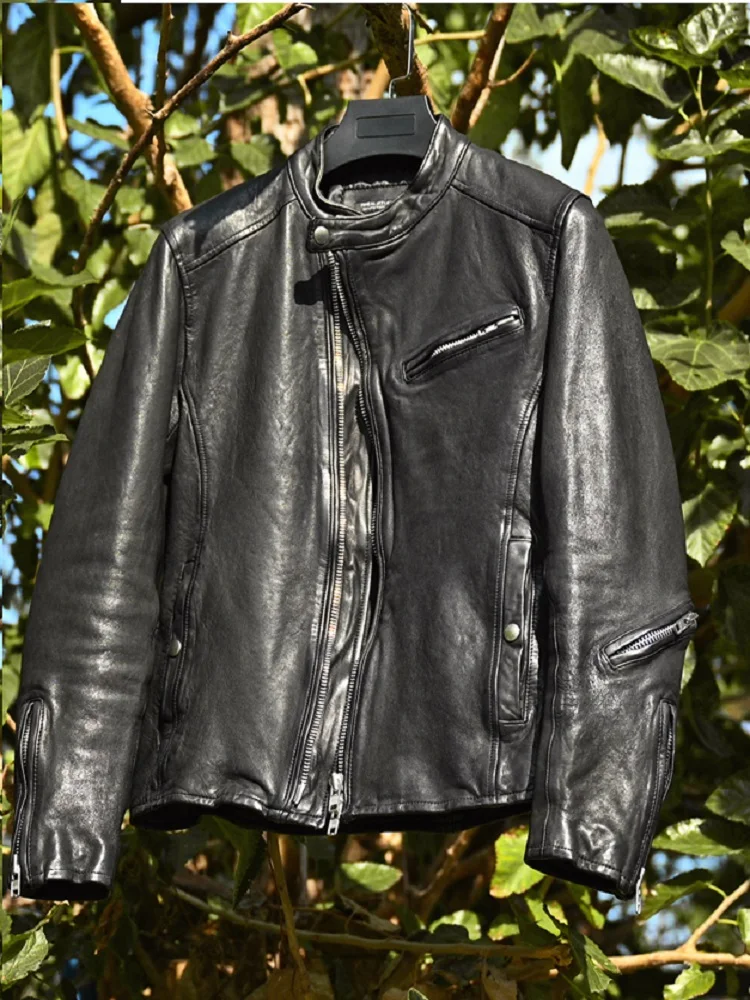
Sophisticated Leather Blazers
For the gentleman seeking to incorporate leather into more refined settings, the leather blazer offers an elegant solution. These structured jackets feature traditional blazer elements like notched lapels and button closures, but with the distinctive edge that only leather can provide.
Distinguishing characteristics of leather blazers:
- Tailored fit with structured shoulders and defined waistline
- Lapel construction similar to traditional wool blazers
- Two or three-button front closure
- Often includes interior lining with inside pockets
- Clean lines without excessive hardware or embellishments
Typically crafted from supple lambskin or goatskin leather, these jackets require exceptional quality hides to achieve their refined drape. The softer leather allows for a more tailored appearance while maintaining comfort and movement.
Leather blazers particularly complement slim to medium builds, creating a sophisticated silhouette that works beautifully in business-casual environments or evening social occasions. They pair wonderfully with dress shirts and tailored trousers for elevated looks.
Quality leather blazers represent a significant investment, typically ranging from $400-1,200, reflecting their complex construction and premium materials. For those seeking versatile, sophisticated options, exploring men’s leather coat collections reveals how these pieces bridge the gap between formal and casual wear.
Aviator/Flight Jackets
Few leather jacket styles carry the heritage and functional design elements of the aviator jacket. Originally created for military pilots, these jackets combine exceptional warmth with unmistakable rugged appeal through their shearling lining and substantial construction.
Signature elements of aviator jackets include:
- Generous shearling collar (often foldable for different looks)
- Insulated interior lining for superior warmth
- Front flap pockets with secure closures
- Adjustable belting or straps for customized fit
- Slightly oversized cut to accommodate layers
Typically constructed from treated, weather-resistant cowhide with genuine sheepskin lining, these jackets offer unmatched insulation against harsh conditions. Their substantial nature generally works best on medium to larger frames, creating a powerful silhouette.
The functionality and premium materials involved in authentic aviator jackets place them at a higher price tier, generally ranging from $350-1,500. The investment delivers exceptional cold-weather performance combined with timeless style.
For those interested in this iconic style, exploring men’s shearling coat options reveals the range of modern interpretations available—from faithful reproductions of classic designs to contemporary adaptations with updated proportions and details.
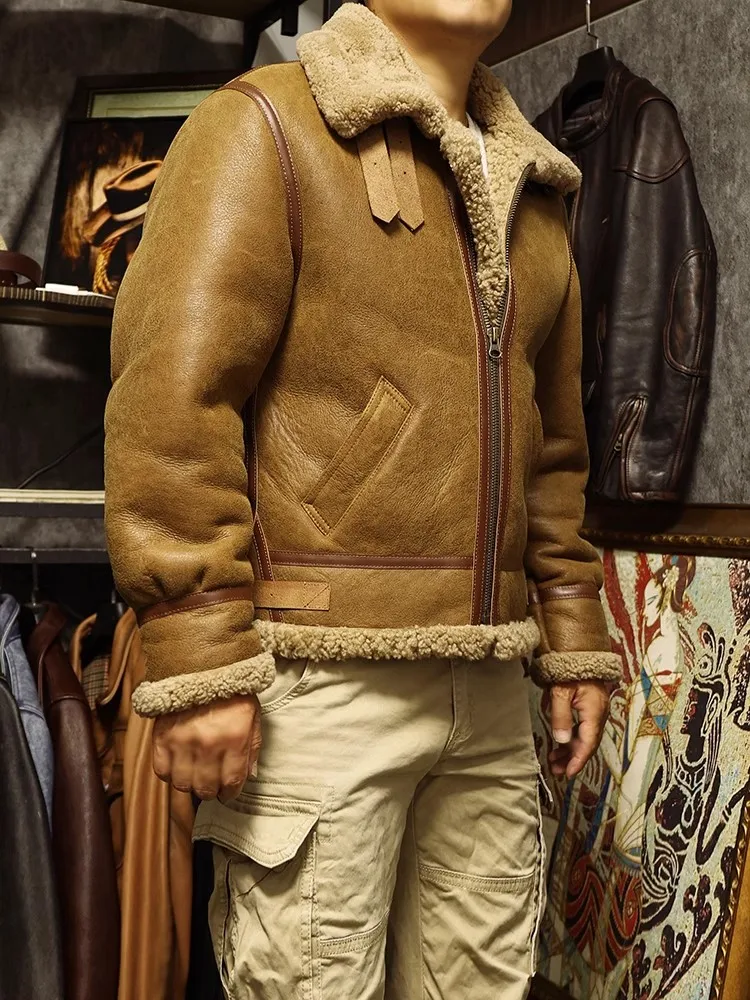
Understanding Leather Quality and Materials
Types of Leather for Jackets
The leather used in your jacket fundamentally determines its appearance, durability, and comfort. Understanding these differences helps ensure you make an informed investment that meets your expectations.
| Leather Type | Durability | Softness | Break-in Period | Best For |
|---|---|---|---|---|
| Full-grain | Excellent | Moderate | Longer (2-4 weeks) | Biker jackets, long-term investment |
| Top-grain | Very good | Good | Moderate (1-3 weeks) | Versatile everyday jackets |
| Corrected-grain | Good | Very good | Minimal | More affordable options |
| Lambskin | Good | Excellent | Minimal | Blazers, luxury feel |
| Cowhide | Excellent | Moderate | Longer | Durability-focused styles |
| Goatskin | Very good | Good | Moderate | Balance of durability and comfort |
Full-grain leather represents the highest quality, using the complete top layer of the hide with all natural grain intact. This provides superior durability and develops a beautiful patina over time, though it requires more breaking in. Top-grain leather has been lightly sanded to remove imperfections, offering a good balance of quality and comfort with less break-in time.
Leather thickness also significantly impacts a jacket’s performance. Heavier leathers (1.2-1.5mm) offer more protection and structure but less flexibility, making them ideal for motorcycle styles. Lighter leathers (0.8-1.1mm) provide greater comfort and drape, better suited for blazers and fashion-forward styles.
The choice between lambskin and cowhide represents a common decision point. Lambskin offers buttery softness and lightweight comfort but with less durability, while cowhide provides exceptional longevity but requires more breaking in. Understanding the genuine leather vs. faux leather differences helps buyers make informed decisions based on their priorities and budget.
Faux and Vegan Leather Options
Modern synthetic leathers have evolved significantly, offering increasingly convincing alternatives to animal leather. Polyurethane (PU) and innovative plant-based materials now provide options for those seeking animal-free products without completely sacrificing the leather aesthetic.
Advantages of quality faux leather:
- More affordable price point ($150-400 for well-made options)
- Consistent appearance without natural variations
- No breaking-in period required
- Typically lighter weight
- Animal-friendly and often more sustainable production
Limitations to consider:
- Generally shorter lifespan than genuine leather
- Less breathability than natural leather
- Doesn’t develop character or patina over time
- May not provide the same temperature regulation
Recent advancements have dramatically improved the look and feel of premium faux leather products, though differences in breathability and long-term durability remain. For those prioritizing ethical considerations, these materials offer increasingly viable alternatives.
Maintenance requirements differ as well—synthetic leathers generally don’t require conditioning but may be more vulnerable to cracking over time without proper care. Learning how to protect leather jackets properly extends their lifespan regardless of material choice.
Finding Your Perfect Fit
Leather Jacket Sizing Guide
Finding the right fit proves especially critical with leather jackets. Unlike fabric garments that offer significant give, leather provides minimal stretch, making proper sizing essential for both comfort and appearance.
Key measurements to consider:
- Chest: Measure at the widest point with arms relaxed
- Shoulders: Measure from shoulder point to shoulder point across the back
- Sleeve length: Measure from shoulder seam to just below the wrist bone
- Back length: Measure from the base of the collar to the desired ending point
When shopping online, comparing these measurements to the provided size chart offers the most reliable approach to finding your correct size. Remember that different styles have different intended fits—biker jackets should fit quite snug initially, while bombers allow for more room.
| Size | Chest (inches/cm) | Shoulders (inches/cm) | Sleeve (inches/cm) | Common Fit Concerns |
|---|---|---|---|---|
| S | 36-38 / 91-97 | 17-17.5 / 43-44 | 23-24 / 58-61 | Often tight across shoulders |
| M | 40-42 / 102-107 | 18-18.5 / 45-47 | 24-25 / 61-63 | Most versatile size range |
| L | 44-46 / 112-117 | 19-19.5 / 48-50 | 25-26 / 63-66 | Check sleeve length carefully |
| XL | 48-50 / 122-127 | 20-20.5 / 51-52 | 26-27 / 66-68 | May need tailoring for sleeve length |
When assessing fit, ensure you can comfortably zip the jacket closed without excessive pulling. The shoulder seams should align with your actual shoulders, and sleeve length should hit at or just below the wrist bone. For a more comprehensive approach to finding your perfect match, the definitive guide to men’s black leather jackets provides detailed fitting instructions for various body types.
How Different Styles Should Fit
Each leather jacket style has its own “correct” fit profile that optimizes both appearance and functionality. Understanding these differences helps you assess fit properly when shopping.
Biker/Motorcycle Jackets
– Should fit snugly without restricting movement
– Arms should feel slightly tight when new (will stretch slightly)
– Length should hit at or just below the waistband
– When zipped, should form a clean line without excess material
Bomber Jackets
– More relaxed fit through body and arms
– Ribbed waistband should sit at hip level without riding up
– Sleeves should have enough room for light layering
– Overall silhouette appears more rounded than fitted
Leather Blazers
– Similar fit to wool blazers—structured but not tight
– Should button comfortably without pulling
– Shoulder seams must align precisely with natural shoulders
– Sleeve length typically shows ¼-½ inch of shirt cuff
Aviator/Flight Jackets
– Roomier cut to accommodate layers underneath
– Slightly longer body than biker styles
– Arms allow for freedom of movement
– Collar should fold properly when worn open or closed
When shopping online, pay close attention to model heights and sizes to gauge how the jacket might fit your frame. Remember that genuine leather will mold somewhat to your body with regular wear, particularly in high-contact areas like elbows and shoulders.
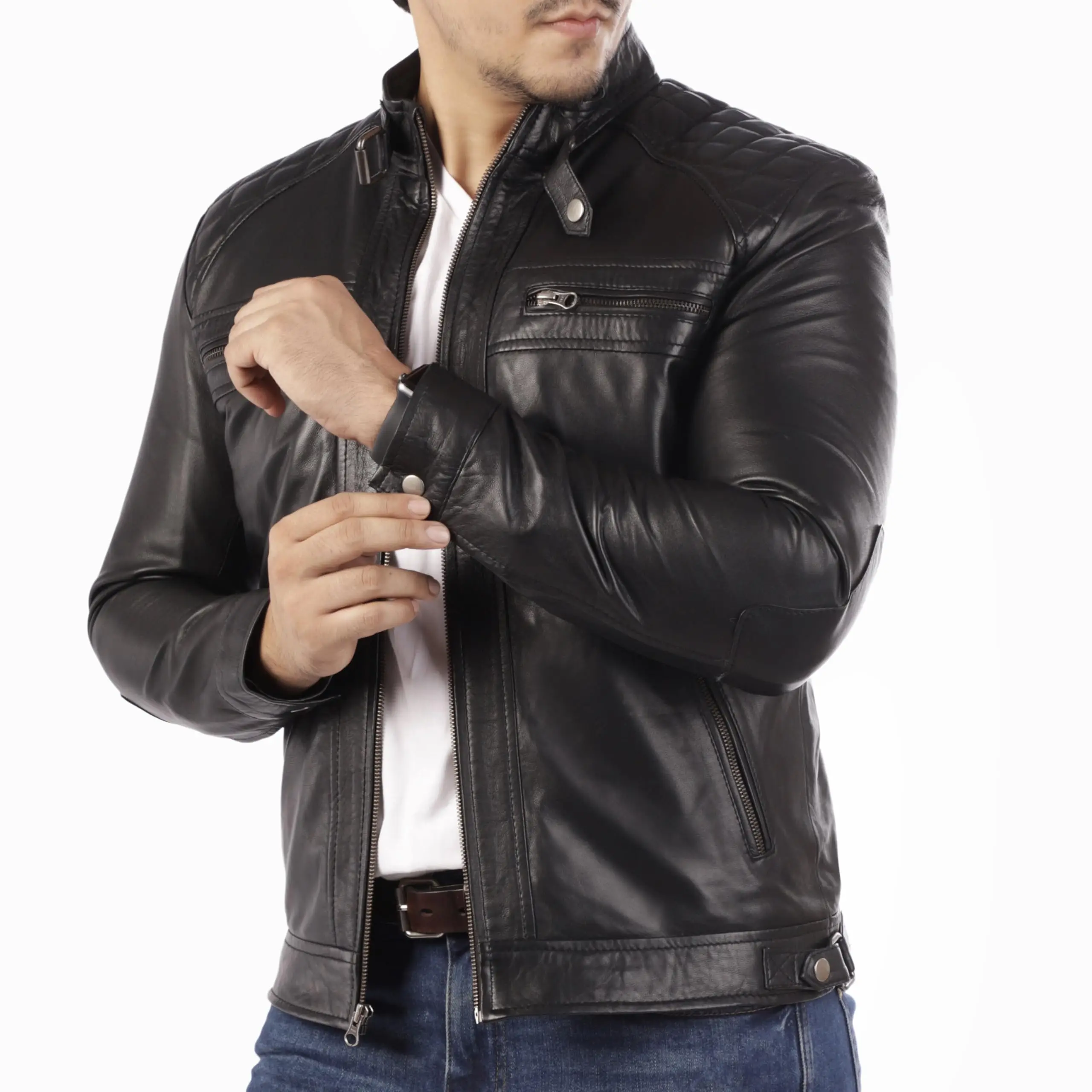
Styling Your Black Leather Jacket
Casual Everyday Looks
The black leather jacket excels as the centerpiece of effortless casual outfits. Its versatility allows it to elevate even the simplest combinations into something distinctively stylish.
Classic casual pairings that never fail:
The Minimalist: Black leather bomber jacket + white crew neck t-shirt + dark indigo jeans + leather sneakers
Weekend Ready: Biker jacket + gray henley + olive chinos + suede desert boots
Elevated Casual: Leather jacket + lightweight merino sweater + slim black jeans + Chelsea boots
For seasonal adaptations, simply adjust your layers—lightweight t-shirts and rolled sleeves in warmer months, or adding scarves and heavier knits in cooler weather. The jacket works year-round with appropriate underlayers.
When selecting colors to pair with your black leather jacket, neutral tones like white, gray, navy, and olive create the most versatile combinations. For added dimension, incorporate different textures like cotton, denim, wool, or canvas to contrast with the leather’s smooth finish.
The versatility of men’s leather shearling coats demonstrates how these pieces transition seamlessly between seasons when styled appropriately.
Business-Casual and Semi-Formal Settings
Contrary to what some believe, leather jackets can work beautifully in more polished environments when styled thoughtfully. The key lies in selecting refined jacket styles and pairing them with appropriate formal elements.
Business-casual combinations that work:
Office Appropriate: Leather blazer + light blue oxford shirt + charcoal wool trousers + brown leather shoes
Smart Meeting Ready: Minimal cafe racer jacket + fine gauge turtleneck + tailored navy trousers + leather boots
For these elevated settings, select jackets with cleaner lines and minimal hardware. Leather blazers and well-cut cafe racers offer the most versatility for business environments. Avoid excessive zippers, patches, or distressed finishes when dressing for more formal occasions.
Accessories play a crucial role in refining these looks—quality leather shoes, minimal watches, and textured scarves add sophistication while maintaining the jacket’s inherent edge.
Evening and Special Occasions
For evenings out and special events, the black leather jacket offers a sophisticated alternative to traditional blazers and overcoats, providing distinctive style while maintaining appropriate refinement.
Evening-ready combinations:
Night Out: Slim biker jacket + black button-down shirt + charcoal trousers + leather Chelsea boots
Dinner Date: Leather blazer + fine gauge black sweater + dark jeans + polished boots
Event Ready: Clean silhouette leather jacket + white dress shirt + black trousers + formal shoes
The monochromatic approach (black leather jacket with black or charcoal underneath) creates a particularly sleek, contemporary look for evening settings. This styling technique elongates the silhouette while projecting confident sophistication.
For accessories, maintain a selective approach—a quality watch, minimal metallic accents, and perhaps a textured scarf in colder months complete the look without overcomplicating it.
Mastering black leather jacket styling for different occasions allows you to maximize versatility from this investment piece.
Mens Leather Coat, Mens Long Leather Coat
Price range: $225.22 through $235.58 Select options This product has multiple variants. The options may be chosen on the product pageMens Black Leather Coat, Mens Leather Coat
Price range: $181.52 through $197.20 Select options This product has multiple variants. The options may be chosen on the product pageMens Brown Leather Coat, Mens Leather Coat
$846.94 Select options This product has multiple variants. The options may be chosen on the product pageMens Shearling Coat, Mens Sheepskin Coat
$888.08 Select options This product has multiple variants. The options may be chosen on the product page- Price range: $96.28 through $130.88 Select options This product has multiple variants. The options may be chosen on the product page
Mens Shearling Coat, Mens Sheepskin Coat
$2,257.19 Select options This product has multiple variants. The options may be chosen on the product page
Investing Wisely: Price Considerations
Understanding Price Points and Value
Leather jackets represent a significant spectrum of investment options, with prices reflecting substantial differences in materials, construction, and craftsmanship. Understanding what drives these price differences helps you invest wisely according to your priorities.
| Price Tier | Cost Range | What to Expect | Best For |
|---|---|---|---|
| Entry-Level | $200-350 | Basic genuine leather, simpler construction, synthetic linings, basic hardware | Occasional wear, trend-focused styles |
| Mid-Range | $350-700 | Better quality hides, full construction, cotton/rayon linings, solid hardware | Regular wear, classic styles with good durability |
| Premium | $700+ | Top-quality full-grain leather, exceptional construction, premium linings, high-end hardware | Investment pieces, maximum durability and comfort |
When evaluating cost-per-wear value, consider how frequently you’ll wear the jacket and your expected ownership timeline. A $700 jacket worn 100 times yearly for five years results in just $1.40 per wear—often less expensive long-term than replacing lower-quality options multiple times.
Quality indicators worth paying more for include:
– Full-grain leather with natural markings
– Fully-lined interior with natural materials
– YKK or RiRi zippers that operate smoothly
– Reinforced stitching at stress points
– Thoughtfully designed pocket placement and functionality
The men’s long leather coat collection demonstrates how premium construction details justify higher price points through enhanced durability and comfort.
When to Splurge vs. When to Save
Strategic decision-making about where to invest helps maximize satisfaction with your leather jacket purchase. Certain elements justify additional expense, while others may allow for more budget-conscious choices.
Worth the extra investment:
– Quality of the leather itself (especially for classic styles you’ll keep for years)
– Construction quality and stitching detail (directly impacts longevity)
– Hardware functionality (zippers and buttons you’ll use frequently)
– Fit accuracy (the most perfectly made jacket holds little value if it fits poorly)
Areas where saving may make sense:
– Trend-forward designs that may look dated quickly
– Highly specialized styles you’ll wear infrequently
– Secondary or situational jackets (e.g., if you already own a primary leather jacket)
– When testing whether leather jackets work for your personal style
Remember that mid-range options ($350-700) often represent the sweet spot between quality and value for most consumers. These jackets typically offer good-quality leather and solid construction without the premium charged for designer labels or exceptionally rare materials.
Proper Care and Maintenance
Essential Leather Care Products
Proper maintenance dramatically extends your leather jacket’s lifespan while enhancing its appearance. A basic care kit requires just a few quality products:
Leather cleaner: Formulated specifically for leather garments, removes surface dirt without damaging the finish. ($15-25)
Leather conditioner: Replenishes natural oils, preventing drying and cracking while maintaining suppleness. ($20-30)
Waterproofing spray: Creates an invisible barrier against moisture while maintaining breathability. ($15-25)
Soft cloths: Microfiber or cotton cloths for application and buffing. ($5-10)
For different finishes, specific products may be recommended:
– Matte or natural leathers benefit from cream-based conditioners
– Glossier finishes often work best with spray conditioners
– Suede and nubuck require specialized brushes and cleaners
A quality care regimen represents a small additional investment (approximately $60-90 annually) that significantly impacts longevity. Proper long-term leather coat care ensures your investment continues looking its best for years.
Cleaning and Conditioning Routines
Regular maintenance prevents most leather issues before they develop into problems. Follow these steps for routine care:
Weekly quick-clean: Gently wipe the jacket with a dry cloth to remove surface dust and debris.
Monthly deeper cleaning (or as needed):
– Test any cleaner on an inconspicuous area first
– Apply leather cleaner with a soft cloth using circular motions
– Focus on high-contact areas like cuffs and collar
– Allow to dry completely away from direct heatSeasonal conditioning (2-4 times yearly):
– Ensure jacket is clean and completely dry
– Apply a small amount of conditioner with a clean cloth
– Use light, circular motions working in small sections
– Allow to absorb for the time recommended by the product
– Gently buff with a clean cloth to remove excess
For spot cleaning, address spills immediately by blotting (never rubbing) with a clean, dry cloth. For stubborn stains, consult a leather specialist rather than experimenting with household cleaners that may cause damage.
Proper Storage and Protection
How you store your leather jacket when not wearing it significantly impacts its condition over time.
Essential storage practices:
- Use wide, padded hangers that support the shoulders without creating dimples
- Allow air circulation around the jacket (avoid plastic covers)
- Store in a cool, dry location away from direct sunlight
- Maintain some space between garments to prevent pressure marks
- Consider a breathable cotton garment bag for dusty environments
For seasonal storage:
– Clean and condition thoroughly before storing for extended periods
– Insert acid-free tissue paper in the sleeves to maintain shape
– Check periodically for signs of moisture or pests
– Avoid storing in basements, attics, or garages with temperature fluctuations
Common environmental hazards include:
– Direct sunlight (causes fading and drying)
– Heat sources like radiators (lead to cracking)
– High humidity (promotes mold growth)
– Prolonged compression (creates permanent creases)
Frequently Asked Questions About Black Leather Jackets
Common Sizing and Fit Questions
Do leather jackets stretch with wear?
Genuine leather does adjust somewhat to your body over time, particularly in high-movement areas like elbows and shoulders. However, this stretching is minimal—typically just 1/4 to 1/2 inch in critical areas. Never purchase a jacket expecting significant stretching to solve fit issues.
How do I determine my size when shopping online?
The most reliable approach involves comparing your actual body measurements to the specific brand’s size chart rather than relying on your typical size in other garments. Pay special attention to chest and shoulder measurements, as these dimensions are most critical for proper fit.
Can I wear thick layers under a leather jacket?
This depends entirely on the jacket’s cut. Bomber and aviator styles generally accommodate layering well, while biker jackets and fitted styles leave minimal room for heavy layers. If winter layering is important to you, consider sizing up slightly or choosing naturally roomier styles.
Care and Maintenance Questions
How often should I condition my leather jacket?
For jackets worn regularly, conditioning 2-4 times per year provides adequate protection. However, exposure to harsh conditions (heavy rain, extreme temperatures) may necessitate more frequent conditioning. Watch for signs of dryness like loss of suppleness or slight creasing.
What should I do if my leather jacket gets wet?
Gently blot (don’t rub) excess moisture with a clean, dry cloth. Allow the jacket to air dry naturally at room temperature away from direct heat sources. Once completely dry, apply conditioner to restore oils that may have been lost. Avoid wearing the jacket until it’s fully dry to prevent stretching.
Can I clean a leather jacket at home or is professional cleaning necessary?
Routine cleaning and conditioning can be performed at home with proper products. However, for significant stains, damage repair, or vintage/delicate leathers, professional cleaning by a leather specialist provides the safest approach.
Style and Occasion Questions
Can leather jackets be worn year-round?
Absolutely. Lighter styles like bombers and cafe racers work well in spring and fall with appropriate layering, while heavier shearling-lined options provide excellent winter protection. Even summer evenings often accommodate leather jackets, particularly in cooler climates.
Are leather jackets appropriate for business-casual environments?
Select styles can work beautifully in business-casual settings when paired appropriately. Leather blazers and minimal cafe racer jackets paired with dress shirts and tailored trousers create refined looks suitable for many professional environments, though traditional corporate settings may still prefer conventional blazers.
How do I know if a style suits my age and personal aesthetic?
The most versatile styles (clean bombers, minimal biker jackets, and cafe racers) work across age groups and personal styles. More specific designs like heavily distressed or heavily embellished jackets tend to be more limiting. Consider how the jacket integrates with your existing wardrobe rather than viewing it as a standalone statement piece.
How to Shop for Black Leather Jackets Online
What to Look for in Product Descriptions
Detailed product listings reveal crucial information about jacket quality. Look for these specific details:
- Leather type and origin: Full-grain, top-grain, or corrected grain indicates quality level
- Thickness specification: Premium listings often provide leather thickness in millimeters
- Construction details: Fully lined, reinforced stitching, gussets for movement
- Hardware quality: Brand-name zippers (YKK, RiRi) indicate attention to detail
- Lining materials: Natural materials like cotton and rayon offer better comfort than polyester
- Care recommendations: Detailed care instructions suggest the manufacturer values longevity
Red flags in descriptions include:
– Vague terminology like “genuine leather” without specific type
– Absence of interior construction details
– Missing information about hardware quality
– Limited or unclear sizing information
The most reputable retailers provide comprehensive sizing details including garment measurements rather than just S/M/L designations, allowing for more accurate size selection.
Evaluating Online Retailers
Not all online leather jacket retailers offer the same quality or service level. Evaluate potential sources using these criteria:
- Detailed product photography: Multiple angles, close-ups of details, and accurate color representation
- Specific material information: Clear descriptions of leather type, thickness, and finishing techniques
- Comprehensive sizing guides: Detailed measurements and fit recommendations
- Transparent policies: Clear information on shipping, returns, and customer service
- Authentic customer reviews: Verified purchase reviews with detailed feedback and photos
- Brand reputation: Established history of quality leather goods
- Responsive customer service: Quick, knowledgeable responses to inquiries
Warning signs that suggest caution:
– Limited product images from single angles
– Generic descriptions used across multiple products
– Prices significantly below market rates for similar quality
– Absence of customer reviews or only perfect 5-star ratings
– Unclear or restrictive return policies
Exploring Metro Cloak’s Premium Leather Jacket Collection
Metro Cloak approaches leather jacket craftsmanship with uncompromising attention to material selection and construction quality. Each jacket begins with carefully sourced hides selected for optimal grain patterns, natural character, and consistent thickness—creating garments that develop beautiful patinas with age rather than simply wearing out.
This commitment to quality extends throughout the construction process. Every Metro Cloak leather jacket features:
- Precision-cut panels that ensure proper drape and fit
- Reinforced stitching at stress points for extended durability
- Premium YKK zippers selected for smooth, reliable operation
- Thoughtfully designed interior linings that enhance comfort and temperature regulation
- Rigorous quality control inspections throughout the manufacturing process
The collection balances timeless design principles with subtle contemporary details, creating jackets that remain relevant regardless of passing trends. This design philosophy emphasizes clean lines, functional details, and proportions that flatter the male physique.
What truly distinguishes Metro Cloak’s approach is the understanding that a premium leather jacket represents more than just outerwear—it becomes a personal signature piece that travels through life with its owner, developing character and personal history with each wearing.

